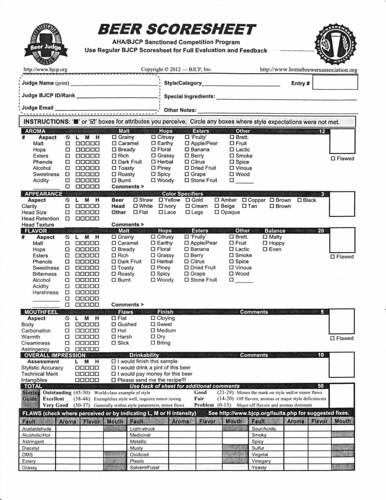Today, a second in an infrequent (ex post facto?) series on reviewing beer.
The first installment was from historian Maureen Ogle: a humorous essay on enlivening a review by bringing in personal experience. Today, it's advice from the BJCP newsletter, on how to avoid "high and mighty snobbery."
The BJCP —Beer Judge Certification Program— trains and certifies judges for homebrew and professional beer competitions. It's a non-profit organization, founded in 1985, "to promote beer literacy and the appreciation of real beer, and to recognize beer tasting and evaluation skills."
At every competition we judge, we are told to ensure that entrants are receiving quality feedback and scoresheets. [...] While it is the duty of each judge to write a proper scoresheet, remember that it is an even worse error to only write a few comments, which is seen from time to time. [...] As the day gets long and judges become complacent, it can begin to creep into sections of a beer’s evaluation by judges of all levels.—Advice for quality scoresheets
One of the easiest way to combat this, and give interested stewards a chance to enhance their judging skills, is a simple discussion. Naturally, this happens at varying levels after every beer, but if you see scoresheets beginning to suffer, take it a step further. All initial notes have been made at this point, but taste the beer again and together highlight the basic aspects of the beer that are listed in each section of the scoresheet. Alternate and discuss.
For instance, in the Aroma section, begin simply by discussing the malt character. What you notice, the intensity, the specific characteristics. Take that next into how it plays with the hop character of the beer. Move to the yeast, and anything else that stands out. Both positive and negative. Just remember to stress how it comes to play versus the style guidelines. If you haven’t taken the time to review the guidelines together, pull them out now and take the opportunity to do it. While this may cause the evaluation of a couple beers to take a bit longer, you will have a refreshed understanding of what the beer should be and what is expected on the scoresheet. This should also help the later beers in the flight move faster, as now there is a greater understanding of the beers being presented to you.
While this may sound like a cliche, and may not be completely possible in every situation, invoking memories about the beer and translating those memories helps to build a better scoresheet. Even if the only memory you can recall is that of another beer or brewery, write that down. While it may be a tricky area saying something such as, “This beer is reminiscent of an -insert brewery name- product”, it shows at a minimum the beer is of commercial grade.
Specific memories typically mean nothing to another person. For instance, how many people out there have tasted your grandma’s homemade rhubarb pie? But in general terms, everyone should at least have an idea of basic concepts even if they have never experienced salt water taffy, charleston chews, or chocolate covered cherries. Getting judges and stewards to reach and expand their thought process while drinking a beer leads to better understanding.
When it comes to the Overall Impression section of the scoresheet, it is easy to discuss major faults and give troubleshooting advice for those. But what about the very good beers that just have minor stylistic issues? The ones that score well but are just missing that unexplainable wow factor. [...]
This can be a difficult section, and sometimes judges struggle with what to include here. Begin by giving your basic thoughts on the beer in regard to the entered style. Also, if the beer is a good example of a style, but not the style entered, be sure to not only say it is miscategorized but where it should go. There are times when entrants received this feedback but they were not told why the beer was out of style or where it should go instead. After that you can move into talking about how the beer missed the mark in sections where it was either not previously discussed or where the “major” issue lies.
Ask the judge you are working with to contrast the characteristics of the beer with the guidelines. While working on those areas, also consider the balance of the beer. The bitterness of a beer can be right for the style but paired with the body or yeast character, there may be a struggle for power. Comments in this vein will give more experienced homebrewers ideas to think about rather than what some see as “high and mighty snobbery” and will give the less experienced homebrewers an idea of what the score they received actually means in regards to their beer.
While consistently creating high quality scoresheets takes time, taking it one section at a time and filling it out as carefully and accurately as you can is of huge value to the brewer. A poorly completed scoresheet has no value to anyone and detracts from the judging process. [...]
BJCP newsletter
Allen Huerta
25 January 2016.
-----more-----
- For more from YFGF:
- Follow on Twitter: @Cizauskas.
- Like on Facebook: YoursForGoodFermentables.
- Follow on Flickr: Cizauskas.
- Follow on Instagram: @tcizauskas.












I wanted to thank you for this great read!! I definitely enjoying every little bit of it I have you bookmarked to check out new stuff you post. birre artigianali on line
ReplyDeletenice nice oldesloer korn
ReplyDeleteYou have a real ability for writing unique content.I like how you think and the way you represent your views in this article.I agree with your way of thinking.Thank you for sharing. Workmanship
ReplyDelete